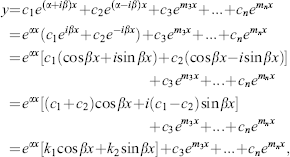Case III. Conjugate Complex Roots
- Suppose that the auxiliary equation has a nonrepeated complex root α + iβ. Then, since the coefficients are real, the conjugate complex number α – iβ is also a non-repeated root. Thus, the solution given in (79) becomes

where k1 = c1 + c2, k2 = i(c1 – c2).
- If two pairs of imaginary roots are equal, then
m1 = m2 = a + iβ and m3 = m4 = α – iβ.
Using Case II, the complete solution is

EXAMPLE 15.83
Solve
Solution. The symbolic form of the given equation is
Therefore ...
Get Engineering Mathematics now with the O’Reilly learning platform.
O’Reilly members experience books, live events, courses curated by job role, and more from O’Reilly and nearly 200 top publishers.

